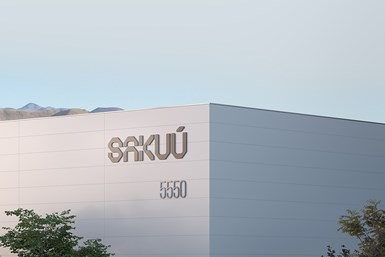Sakuu Opens Silicon Valley Engineering Hub
The company says the engineering hub will advance its domestic battery printing initiatives and serve as a gateway for at-scale battery printing gigafactories globally.
Share
Sakuu says its new engineering hub in Silicon Valley will advance the company’s domestic battery printing initiatives and pave the way for its future 3D printing platform gigafactory. Photo Credit: Business Wire
Sakuu, developer of the world’s first 3D printed solid-state battery, says it has opened a state-of-the-art, multifaceted engineering hub for its battery platform printing initiatives in the Silicon Valley. This multimillion-dollar buildout follows the recent opening of Sakuu’s battery pilot line facility which currently produces batteries for clients.
“We are in a rapid growth phase due to strong demand for our forthcoming printed batteries,” says Sean Sharif, Sakuu vice president of global supply chain and logistics. “Our new facility paves the way for our first 3D printing platform gigafactory, dubbed Sakuu G-One. The facility will allow our teams to fine tune all aspects of our battery printing technologies to enable swift deployment of our gigafactories.”
Sakuu’s new facility is 79,000 square feet and will be used as the company’s flagship engineering hub. It will house a confluence of teams, including battery, engineering, material science, R&D and additive manufacturing (AM). It will also oversee gigafactory employee training and client product demonstrations. It is estimated to house 115 employees by the first quarter of 2023. It is said the facility will also enable Sakuu to scale its 3D printing battery platform as the company looks to open gigafactories around the world with a total energy output goal of 60 GWh by 2028.
“Sakuu is committed to building an extremely talented workforce that wants to be part of our reinvention of sustainable energy production,” says Robert Bagheri, Sakuu founder and CEO. “We are on a mission to build a company and brand that is driven by transformative products that can leave an impactful legacy for societal and environmental change.”
The new facility will showcase two of Sakuu’s flagship products. First, Sakuu’s Kavian platform which the company says is the world’s first at-scale 3D printing platform capable of rapidly printing safe, ultrahigh-energy density, solid-state batteries in custom shapes and sizes. Second, Sakuu’s nonbattery manufacturing platforms capable of producing medical devices, IoT sensors, and other cutting-edge electrical devices — all produced in a sustainable and efficient manner.
Sakuu’s battery cells are designed to deliver best-in-class performance and safety in a recyclable format. Sakuu’s solid-state batteries will be produced entirely through the Kavian platform in custom or large factory settings, which enables rapid, 3D printed, high-volume, low-cost and sustainable battery production to meet mass market demand.
Related Content
-
ConocoPhillips Sees Oil and Gas Supply Chain Opportunity With Additive Manufacturing
Production of parts when needed and where needed can respond to the oil and gas sector’s multibillion-dollar challenge of holding parts in inventory. The supply chain benefit will justify additive even before the design freedoms are explored.
-
Researchers Use Additive Manufacturing to Make Aircraft Propulsion Systems More Eco-Friendly
Project researchers aim to utilize hydrogen fuel cells and additive manufacturing as a pathway to achieve low-emission aviation by 2050. The goal is to recuperate the waste heat of a fuel cell-electric propulsion system, paving the way for a clearer, more sustainable future in aviation.
-
3D Printed Reactor Core Makes Solar Fuel Production More Efficient
The solar reactor uses water and CO2 from the air and sunlight as the energy source to produce carbon-neutral liquid fuels, for example, solar kerosene for aviation.




